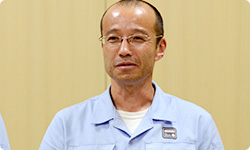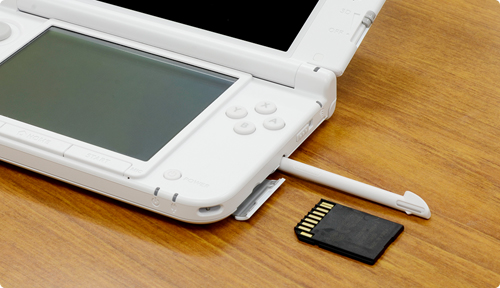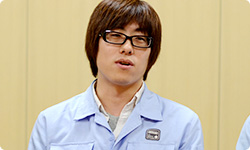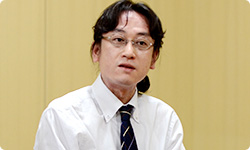4. More Than Just Bigger
Tanaka-san, sorry to make you wait so long.
No, no, not at all! (laughs)
Could you tell us about what you tried to do in support of the software for Nintendo 3DS XL?
Sure. The top priority with regard to the software was to make it as identical with Nintendo 3DS as much as possible, to not place a burden on game developers.

As a fully compatible hardware, the same software has to run smoothly on it so that game developers and gamers alike don’t notice any differences.
Right. But some things simply had to change, so we made appropriate adjustments to keep those things to a minimum.
So software programmers wouldn’t experience any hiccups in absorbing the hardware differences.
Yes. But when we started the Nintendo 3DS XL project, a lot was still secret even within the company, so keeping all that in the dark, while at the same time moving forward, was one of the hardest things.
Oh, I see. (laughs) Different approaches become necessary depending on how you make preparations in an environment in which you have to keep information from spreading widely throughout the company. Exactly what aspects changed?
In graphics, for example, there are explanations for the players about hardware features, like about where to place the stylus and where to insert the SD Card. On Nintendo 3DS XL, those places have changed. Please note: this colour of Nintendo 3DS XL is not available in South Africa.

The SD Card slot has moved from the left side to the right side and you remove the stylus from the side. You address each of those points.
Yes. The material of the stylus has also changed, so we changed the text about such things. More changed than we at first expected, so we had to work hard to handle them all.
Software-wise, a big change was the click for the 3D depth slider.
Oh, the moment when you switch from 3D to 2D, there’s now a click to it.
It’s the same system as Nintendo 3DS, so aside from the click, we adjusted the various values of each process so it would run the same.
That usually requires adjustments between a lot of departments.
Yes. If you talk on the phone, others will be able to hear, so we mostly used e-mail.
Making such preparations in secrecy is pretty difficult.
In a number of ways, it really was hard work! (laughs)
I see. Returning to the hardware, I think that many players are worried about strength and durability due to the greater size and weight of Nintendo 3DS XL. I think the hurdles in those respects were quite high. Did you have difficulties?
Well, we already knew the structural weaknesses and where applying pressure was likely to break it.
How do you identify such points?
Checking after making the actual machine lacks speed and will take too long, so first we simulated the design data, and, armed it with certain estimates and checked it as we went.
You can tell somewhat before making it.
Yes. We were able to narrow it down to a certain extent, made prototypes, and fine-tuned them.
What did you pay attention to in simulations for Nintendo 3DS XL?
The upper screen is bigger, so we paid attention to the hinge for supporting that weight. The weight of the casing on the upper side that needed to be supported has increased, so - simply put - the hinge has roughly twice the torque10 compared to Nintendo 3DS. 10Torque: Directional force for rotating an object. Torque is measured in newton metres (N•m).

Twice? But if you didn’t make it that strong, it wouldn’t be able to firmly support that weight.
Right. Some forms of gameplay use all the system’s various sensors, so that much strength was necessary to ensure that the upper half wouldn’t fall over.
But that doesn’t mean that stronger is always better.
No. It can even get easier to break. We actually took samples to our Repair and Maintenance Centre and Customer Service Office and had them look at it. They tried them out and repeatedly fine-tuned them in degrees of one newton centimetre.
Then you need a part that can withstand that much torque.
Yes. With the existing design the support of the hinge pin wasn’t strong enough. I took advice from Koshiishi-san, and made a separate part made of special plastic. We were able to achieve high torque while also saving space.
I see. So you used a special plastic just for that part?
Right. And to increase strength, we beefed up design review, in addition to running simulations.

What is design review?
We gathered specialists in various fields and examined the designs before making the trial models. We explained our designs, had the specialists raise concerns, and then reflected those concerns in the designs. We did that more often and earlier this time.
You included the experience and expertise of specialists from various fields.
Yes. From an earlier stage than before, we carried out co-operative work between the development design department and the section in charge of manufacturing. We went early on to hear opinions from the Repair and Maintenance Centre and Customer Service Office.
What other opinions did the Repair and Maintenance Centre and Customer Service Office have?
A big one was the design of the battery cover groove so it could be removed.
Oh, that’s right. The external IMD parts are quite different than before, but players may open the battery cover to remove the battery, so we discussed the ease of doing that.
You usually wouldn’t want to be able to take it off too easily, but it has to be convenient for when you do want to remove it.
We really debated that, like whether there should be screws, their placement, and the shape of the fingerhold.
The Repair and Maintenance Centre and Customer Service Office hear a lot of comments from customers, so they can give real advice.
Yeah. At first, there was a projection on the battery cover. That made it easy to remove, but it’s at a place where it could be obtrusive when using the L and R Buttons, and there were concerns that people may try to remove the cover before they remove the screws. So we decided, “That just won’t do!” (laughs)
(laughs)
So we took in all kinds of samples without projections, and eventually settled on one of those designs after putting in consideration about how often it would actually be removed.
Other changes happened along the way, and our contracting factory in China helped us a lot with things like assembling the metal mould and the colouring.
The more I hear what you have to say, the more I realise that this was about a lot more than just making it bigger. When the screen is 90% bigger and it weighs 40% more, a lot has to be reconstructed. It’s not just the hardware development department, but many other departments and participating companies are involved from an early stage.